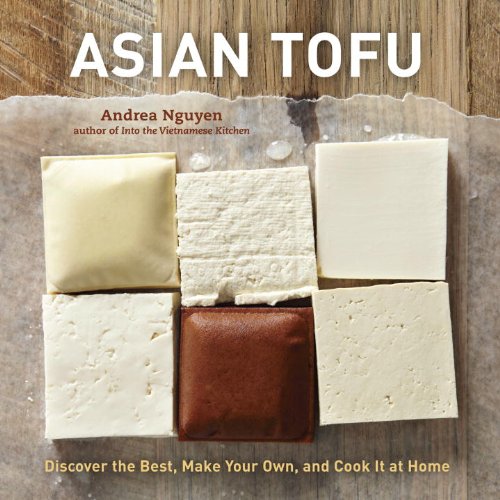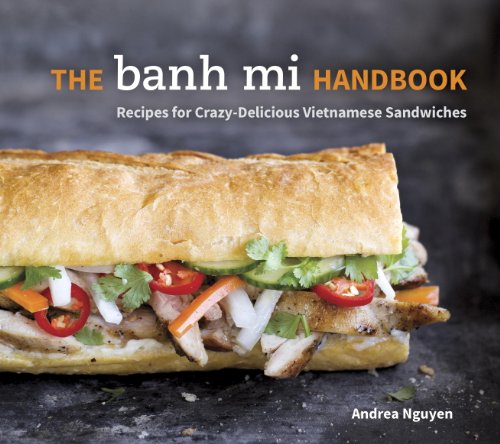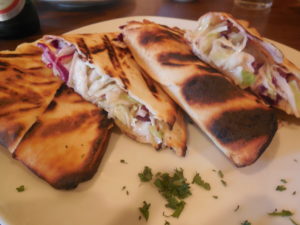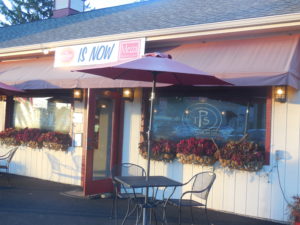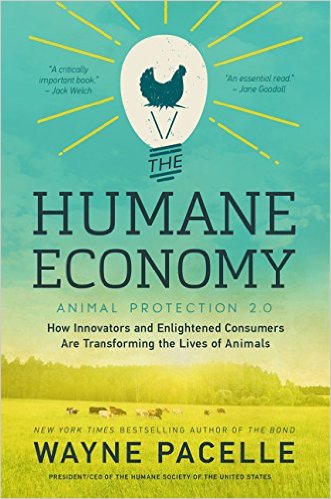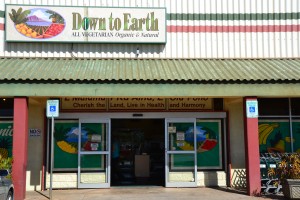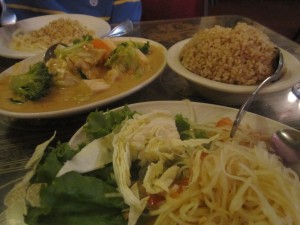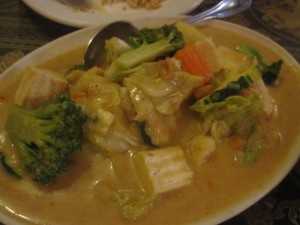Tag Archives: plant-based
VEGANIZE IT! Easy DIY Recipes for a Plant-Based Kitchen
BY Robin Robertson – Houghton Mifflin Harcourt March 7, 2017. $25. Amazon $14.92/ Kindle $12.99
Another really good book from one of the top vegan cookbook authors. Robin Robertson’s books are classics and I have most of them. So I had high expectations for this one. It’s a beautifully designed book with a stiff fold-in cover for marking your place and lots of full-page photos and chapter intros that sometimes bleed across a double-page spread.
The chapters are similar to those of an omnivore cook book – with a twist. Plant-Based Meats, Vegan Charcuterie, Instead of Seafood, Dairy-Free and Egg-Free, Too…. all very enticing.
Since 2010, I’ve been turning to Steen & Newman’s “The Complete Guide to Vegan Food Substitutions: Veganize It! Foolproof Methods for Transforming Any Dish into A Delicious New Vegan Favorite.” And collecting recipes from chef-written cookbooks, blogs and the www. There have been so many advances in plant-based cooking in the past six years that I thought Roberstson might, essentially, be providing an updated, cutting edge version of “The Complete Guide…”. And in some ways she has. But I was hoping for some break-through ideas instead of riffs on existing chef or blogger-developed veggie cuisine. Or at least a compilation of those best of the best ideas. But I misunderstood the intention – which might have had something to do with the similarity of the titles…..
Instead, the book provides “clean” vegan recipes for lots of basics like sour cream cream cheese, cheesy sauces, ricotta, hollandaise, feta, butter!, gravy plus many, many more. Beyond basics are burgers, pulled pork, fish ‘n chips, sausages, meatballs, sea scallops, five bacon recipes, and more. Many of these products are available in the supermarket freezer or refrigerator case but made with a laundry list of additives and other unpronounceable ingredients. So this is why I add the word “clean.” Ms. Robertson first chapter includes home-made versions of pantry items (many of which are not vegan in their store-bought versions). Each chapter also includes more involved recipes that use a few of the basics made from the included recipes or, if time is short, from store-bought versions.
I started my review by preparing a couple of the recipes. First was Creamy Ranch Dressing that starts with 1 cup of mayo – it had good flavor but the mayonnaise was too prominent so I cut it with a little almond milk that also made it more pourable. The second one was Cheddary Sauce which is pictured below (these are my photos, not from the book). This was a tasty cream sauce and it worked well over a steamed veggie and quinoa bowl, but it didn’t taste anything like cheese, especially cheddar, which the name implied. I made it in a Vita Mix so just letting it blend a little longer heated it up – once the cashews had been soaked, it was quick and easy despite a lengthy list of ingredients. I will make it again – perhaps amping up the seasonings and playing with the liquor choices. Next up are the five bacon recipes and the pulled pork.
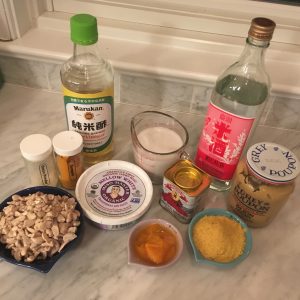
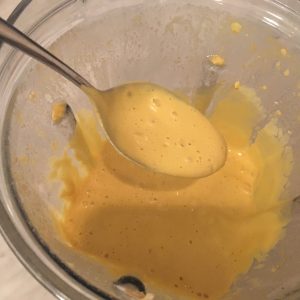
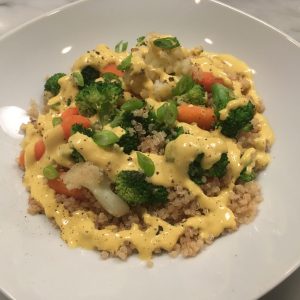
A couple nitpiks: Recipes labeled with cheesy names have to taste cheesy – nooch just doesn’t taste cheesy to me. And there isn’t any nutritional info – I’d like to know the calorie count and the percentage from fat – is it a 30-cal tablespoon or a 125 cal one? Also while the cashew craze has been well addressed, alternatives would be appreciated (since cashews are high-FODMAP) and a little more on aquafaba would also be helpful and suggestions for those among us who choose oil-free.
Bottom line – this book is a keeper. There are enough interesting concepts in here to encourage experimentation. It is not haute cuisine, but it is reliable, tasty, clean vegan. And that’s worth a lot.
Good Clean Food Shopping Smart to Avoid GMOs, rBGH and Products that may cause Cancer and other Diseases
By Samuel Epstein, MD and Beth Leibson – Skyhorse Publishing 2013. $24.95/ Amazon $16.99, $6.50 used
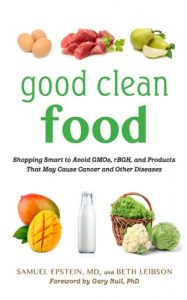
Dr. Epstein is a voice we should hear. His long and deep expertise on the avoidable causes of cancer has been shared in twenty books and 270 peer-reviewed articles. He is professor emeritus of environmental and occupational medicine at the University of Illinois School of Public Health and chair of the Cancer Prevention Coalition. He has also served as president of the Rachel Carson Council and other industry organizations. Co-author Beth Leibson knowledgeably unpacks this far-ranging erudition to make it accessible and understandable to the layperson.
This is a short read outlining important concepts that are clearly described – the main foci are:
Milk – the US permits the injection of the genetically-engineered growth hormone (rBGH – named by Monsanto Posilac) into dairy cows which causes elevated concentrations of IGF-1 (Insulin-like Growth Factor). The upside is that it increases milk production by 11-15%, the downside for the cow is that they get sick, for instance 25% get mastitis which adds more pus to the milk and which also requires antibiotics. About 20% of dairy farms in the US inject their herds with rBGH which creates IGF-1 but, since labeling is not required, consumers have no idea. The downside for the consumer, in addition to the antibiotic load, is that IGF-1, which is not destroyed by pasteurization, encourages cells to grow – in children it’s usually bones and organs, in adults it can be cancer cells. So, if you choose to continue to use dairy products, buy only organic from grass-fed herds. BTW: The EU and Canada outlawed rBCH and IGF-1 in the 90s. Better yet – plant milk.
Beef – Starting in the ‘50s, US cattle have been injected and/or fed a wide variety of sex hormones and other growth drugs. Today that cocktail, injected into 90% of all US cattle, contains natural estradiol, testosterone, and progesterone plus synthetic hormones zeranol, trenbolone, and melengesterol – all designed to add quick weight and roughly $80 additional profit per animal. The EU outlawed this practice in 1989. Industrial farmed meat cows are also fed prophylactic antibiotics which has contributed to the creation of superbugs that jump to humans and are resistant to most if not all antibiotics. Other beef topics include nitrates (and the link between hot dogs and pediatric brain cancer), radiation, the significant advantages of grass-fed beef and, again, the need for labeling.
Produce – The Dirty Dozen/Clean Fifteen – The Environmental Working Groups master list of the dozen most likely fruits and vegetables, when conventionally grown, to be drenched with pesticide – add kale and collards to the EWG list. The Clean Fifteen lists those least likely to be tainted. The authors also suggest buying “American” since imported produce usually contains higher percentages of pesticides. This chapter then details the negative effects of these insecticides and herbicides, many of which contain Organophosphates, which has been shown to block acetylcholinesterase that stops nerve cells from firing. The demonstrated effects include increased incidences of ADHD, autism, reduced memory and lowered IQ. The answer is organically grown produce.
Corn and Soybeans & GMOs – These are the two most prolific foods on the planet; corn, for instance, provides over 20% of all human nutrition – but both are largely used for animal feed. Both can be cultivated as vegetables or as oil or as…. The broad-spectrum herbicide Roundup, a ramped up version of Glyphosate (which is a type of organophosphate), was developed by Monsanto to increase field yields. Monsanto also developed many Roundup-ready, patented crop seeds that can tolerate the pesticide. Initially Roundup works, but then, over time, the weeds become resistance and the farmers find it necessary to increase the quantity of Roundup creating more dangerous conditions for farmers and consumers. Glyphosate-resistant alternatives exist but share the same problems – they kill off amphibians as well as pests and weeds and they contain an inert ingredient (a surfactant) to help the chemicals penetrate the plants which has shown to be harmful to humans. A newcomer is Bt corn (Bacillus thuringiensis), a plant that exudes its own pesticide which is also dangerous to other living things, like butterflies and humans. The chapter concludes with a review of the politics as well as alternatives – especially non-GMO organic.
Chicken & Eggs – Conventionally raised chickens (and eggs) are fed a wide range of ingredients to encourage speedy growth including prophylactic antibiotics – which pass to humans creating similar problems to those of beef. At first brush, the answer seems to be organic. In order to be labeled organic, broilers and egg-laying hens alike, must be fed organic feed without antibiotics (except for illness), hormones or pesticides and they must have access to the outdoors. An organic egg comes from an organic laying hen. But beware the various levels of “organic” – large-scale industrial and some family-size organic egg farms may offer an open door with an impenetrable maze to access it so there is no “scratching in the dirt.” The key descriptor seems to be “pasture-based” or “free-range” organic where mobile housing moves frequently to fresh fields and the birds are outdoors as often as inside. All of this applies to “broilers” as well.
Avoiding GMOs – This gets harder every day; again look for the word “organic” otherwise almost any, for instance, soybean or soybean derivative will likely be from GMO plants– but at least know the legal definitions: “100% organic” means just that. “Organic” means 95% of ingredients are. “Made form Organic Ingredients” 70-94% is organic. The word “organic” on the ingredient panel only means that less than 70% is organic. An on fruits and vegetables – look for a label with a 5-digit number beginning with 9 – that’s organic. Beginning with an 8 means GMO (but that’s rarely labeled). Four digits beginning with 3 or 4 means conventional.
The remainder of the book discusses detoxification and future trends like Budget organics – private labels, Farmers’ markets, CSAs Buying clubs, Food Co-ops. And trends among various ethnic groups and around the world – all of which are well worth reading. Finally check out the organic industry watch dog: Cornucopia Institute www.cornucopia.org.
Asian Tofu
by Andre Nguyen. Ten Speed Press 2012, Large format, hard cover $30 ($23.56 or $12.99 Kindle)
The only book that I owned on making tofu was the “Book of Tofu” by William Shurtleff and Akiko Aoyagi circa 1979. It’s a very yellowed, dense paperback ($2.95 then*) filled with tons of information. But somehow it always intimidated so when I picked up Nguyen’s “Asian Tofu” with lots of big, beautiful photos, graphics and white space (albeit at ten times the price ), I was encouraged to try this again.
Not surprisingly the basic recipe that Nguyen uses is almost the same as Shurtleff’s – she just makes it sound easier. It’s soybeans, water and coagulant with a proper mold and accoutrements – that’s pretty much it. Nguyen begins with a highly detailed Homemade Tofu Tutorial: an immersion in the various types starting with soy milk, then on to silken tofu, tofu pudding, block tofu, seasoned pressed tofu, tea-smoked pressed tofu, white fermented tofu, fresh tofu skin and soy-simmered fried tofu. The rest of the book is devoted to how to use each kind of tofu once you successfully mastered it. Again, the photos are the name of the game here. Seeing the process and knowing what you’re going for makes all the difference. She has encouraged me to try this to see if the result is as good as or even better than the lovely artisanal product produced by The Bridge Company in Middletown, CT. (I was privileged to spend several hours there watching the process – seeing how very minimally processed this product can be.)
Nguyen continues to teach the reader/cook through chapters on Snacks and starters, Main Dishes, Salads, Mock Meats, Buns, Dumplings, Crepes, and Sweets. . She ends with a chapter on Basics that covers stocks, and sauces. Be aware this is not a totally plant-based book. There are many recipes using seafood and meat. But, as in her earlier book, plant-based substitutions are relatively easy and it is a host of basic concepts that she is teaching.
*BTW: The original “Book of Tofu” is still available for $7.23 on Amazon (used $0.1 and up) and a new edition, “Book of Tofu – Protein Source of the Future… Now!,” a larger paperback with photos, updated information and newly designed covers, was published in 2012 ($17.95, available from $8 up). That might be well worth purchasing. Together these two books will tell you all you want, need or wish to know about tofu.
The Banh Mi Handbook – Recipes for Crazy-Delicious Vietnamese Sandwiches
by Andrea Nguyen. Ten Speed Press 2014. $16.99 (Amazon $11.43, or $4.99 Kindle)
Banh Mi sandwiches have been the subject of so many articles and restaurant reviews that they have certainly captured my imagination and my salivary glands. But they are so meat-centric that I just couldn’t figure out how to replicate this described deliciousness within the confines of even a flexible plant-based diet. Nguyen’s small, hard-cover book helped me figure that out. This is by no means a vegetable-forward book; the bulk of the recipe chapters cover all of the main meat, poultry and seafood categories. But, there is a chapter on vegetarian fillings, two on breads and other “holders,” and, probably most important, one on mayonnaise, sauces and pickles which form the flavor profile that makes Banh Mi sandwiches so addictive. So you might find it worth the investment in a Kindle version for the Baked Maggi Tofu, Edamame Pate or the four other vegan fillings or for the flavorings of her meat pates that could be reinterpreted in a mushroom or bean pate.
The Humane Economy: how innovators and enlightened consumers are transforming the lives of animals
by Wayne Pacelle, Presdient & CEO of the Humane Society of the United States. William Morrow. April 2016. Hard Cover $18.38, Paperback $12.99 (March 2017), Kindle $12.99
Mr. Pacelle covers the whole enchilada of animal abuse in the US – from puppy mills and dog fighting to battery cages and gestation crates to animals in film, wildlife management, animal testing to stepping outside the US to Africa’s wildlife. It’s an upbeat, well-done, informative overview that hails the HSUS’ successes but with only one chapter devoted to each issue, depth, naturally, suffers. That said, the case studies on PetCo and PetSmart that describe how lobbying moved them from selling puppies and kittens to partnering with local shelters to host pet adoptions were impressive. My interest in reading it was to hear his perspective on factory farming and if that is your sole interest, then the two chapters devoted to this topic might not justify the purchase, but if your library has it, then by all means borrow it. It’s a good read and will draw you into areas of animal abuse that may not have been on your radar screen. Note: I read this in hard cover; there’s also Kindle version and in 2017 a paperback – if the Kindle version is anything like the posted sample (devoid of paragraph spacing) then reading in that format will be challenging.
Mala at Wailea Marriott – unexpected plant-based meal in a spectacular setting
Searching out plant-based, vegan options in Maui proved a positive and fun adventure. The biggest surprise, not listed anywhere, was the restaurant at our hotel. What a surprise! Mala has a separate Gluten-Free & Vegan Menu. Chef Mark Ellman and his business partner Shep Gordon teamed up with Top Chef Finalist Chef Sheldon Simeon (and one of Food & Wine 2014 Best New chefs) to create delicious, organic and locally sourced dishes that are an eclectic blend of Mediterranean and Hawaiian flavor profiles.
The setting is simply gorgeous. The upper level airy dining room features a clean, contemporary, teak-accented look with long, unobstructed water views. If weather permits, dine on the lanai.
On the Gluten-Free and Vegan Menu , there are four vegan starters, one salad, and a disappointing single entree. But we found that the server and chef were happy to work with us to create a second plant-based entree since we always share and prefer to taste a variety of offerings. We combined one of the starters with a few of the five vegan sides. Island Vegetables featured well seasoned cauliflower, mushrooms, carrots and baby bok choy on a bed of coconut peanut sauce ($28). We also sampled the fried local pickels ($7) and the Fried Tofu ($12).
Eating Plant-Based in the British Virgin Islands
Provisioning for a whole foods, plant-based diet is pretty easy in the BVI if you are on a charter yacht or staying in a villa. On Tortola, recently renovated Rite-Way about a quarter mile from the Moorings Charter Yacht Base (the largest in the world) has a good assortment of grains, beans, produce, some frozen veg entrees, soy milks and Bobby’s even has local tofu. You can buy home-made hummus at the Patisserie on the Moorings entrance road – and until recently they had a fab tofu salad (we keep asking when it’s coming back). There are tubs filled with a variety of pickles (delicious cornichons) and lots of olives. Even the little market in Leverick Bay Resort & Marina on Virgin Gorda – on the southern edge of North Sound – has frozen vegan entrees.
But if you wish to dine out, and have the full BVI experience, then things get a bit more challenging. Vegetarian is, of course, easier because chefs sub cheese for meat. It seems the higher end restaurants are beginning to recognize the sea change (and, of course, the Rasta eateries and stands are always ready with a quick meal). But we have ferreted out a few places that offer a lovely ambiance, spectacular views and offer at least one whole food, plant-based app and one entree right on the menu.
Saba Rock Resort in North Sound is accessible by their ferry from Leverick Bay or Bitter End Yacht Club or by dinghy from your boat moored right off this one-acre bit of paradise. Rooms are simple and immaculate and the menu offers several vegan entrees: For lunch at The Pub, try three black bean crispy tacos ($16.95) , Black Bean Veggie Burger ($14.95) or a vegetarian traditional West Indian Curried Roti. Everyday from 4-6pm, it’s Happy Hour with $2.50 Painkillers, Rum Punch & Carib Beer. For dinner, there’s an all-you-can-eat buffet that features a fresh salad bar and a wide range of hot entrees ($29.95) check to see if they’re vegan offerings that night. Among the a la cart entrees is a dinner size West Indian vegetarian Roti ($29.95) or Cuban-style Fire-Roasted Vegetarian Kebobs ($27.95) featuring mini black bean cakes – accompanied by the salad bar. Tables are literally right on, actually over, the water – so it’s easy to watch the large schools of Tarpon circling the underwater lights or look across the bay filled with yachts on moorings. Contact – (284) 495-9966 or VHF Ch. 16.
Just across the Sound, the famous Bitter End Yacht Club resort is not so accommodating – and that was a bit of a shock. There are four eateries. We ended up with Conch Fritters on the premise that there is so little conch in conch fritters that it was irrelevant – and we needed something to sop up the wine and beer. They might have been able to rustle up a simple salad or a steamed/grilled veggie plate or white pasta with red sauce had we asked, but there is nothing on their menu that works (even modified) and we just weren’t up for another heavily oiled, uninspired veggie plate or pricey but lackluster pasta with tomato sauce from the kids menu – no matter how gorgeous the view. But if you are looking for fresh bread and other bakery items for the galley – head to Winston’s.
Around the corner, Leverick Bay offers three dining options. Chef George’s upper level fine dining room offers a tomato and mozzarella salad ($15) or Bruschetta ($11) that can be made without the cheese. For an entree, there’s a Creamy risotto, beurre blanc, seasonal vegetables and aged balsamic topped with crispy carrots (leave out the cheese and/or buerre blanc). The Cove and Bar offer more veg friendly options: Garden Salad ($12) or Hummus and pita chips ($12) to start followed by a Veg Pizza (skip the cheese $19). Entertainment is excellent. Michael Bean’s pirate bit Mon-Wed 5-7 pm is always well-attended and a family fave. We spent a week in their mooring field and never tired of his bits). Friday night’s the Beach BBQ (we found lots to eat on their vegetable forward buffet) that features the must-see Moko Jumbie Dancers and Thursday nights it’s the Salt and Pepper Shakers.
Around the corner, at Biras Creek Resort, we really loved the Fat Virgin’s Cafe overlooking the dinghy dock. Brightly colored picnic tables were awash in local specialties – so we always found something delicious to eat. Sadly, Biras Creek closed – we don’t know for how long or what happened to the cafe – so call.
Overlooking Manchioneel Bay, private, secluded laid-back Cooper Island Beach Club (accessible via their private ferry from Road Town or dinghy in from the mooring field) has been one of our all-time family favorites – and it just keeps getting better and better. But it’s been sooo discovered that getting a mooring requires a first-light run. The chef offers a Roasted Garlic Hummus Wrap with artichoke hearts and Cajun fries ($11) on their lunch menu. Unfortunately their Traditional West Indian Roti, which our son rates very highly, is made with chicken (maybe they will offer a veg alternative soon). For dinner they offer hummus as a starter and Penne with sauteed vegetables and a pesto-tomato Sauce ($20) as an entree. Another possibility, Eggplant Rolls filled with goat cheese and red peppers ($19), might be doable without the cheese. We understand that they will also accommodate gluten-free, so this seems a very real option. Happy Hour is 4-6pm with two for one drinks. Rooms are available at the Beach Club or around the island at Cooper Island Villas.
Vegetable Rotis, like the ones served at Saba Rock, are an authentic taste of the Caribbean that originated in Trinidad. It’s a a large flatbread filled with curried meat, fish or vegetable – kind of like a huge burrito. We are always on the look-out for the vegetable versions, not too hard to find, and one of the very best is served at the little Roti Palace, tucked behind Samarkand Jewelers on Old Main Street, Road Town Tortola ($10-25 for lobster). There’s a little dining area and an outdoor patio – or take-out. (They’re hand-made so be prepared to wait a bit.) If you want to be 100% sure there is no chicken or fish stock in your roti, look for a Rastafarian restaurant that serves I-tal food – which is strict vegetarian.
Pirates Bight Restaurant on Norman Island re-opened in December 2012 with a beautiful, brand new, larger facility. The dinner menu features a “Vegetarian’s Delight” ($28) that changes daily – hopefully their delicious West Indian Vegetable Roti filled with traditional curried spiced vegetables will be on the rotation. There’s also a trio of veggie salads: Greek Bounty salad – sliced tomatoes, cucumbers, feta cheese, olives, with fresh pita and home made hummus ($16), Garden ($13 ) and Fruit platter ($12). It appears that lunch is no longer served (there used to be a vegan roti, veggie burger topped with grilled pineapple, fresh tomato, lettuce and onions, and grilled veg panini). Thursday through Sunday, the music starts at 8 pm (and Wednesday is Karaoke). Happy Hour is 4-6 pm; the bar menu offers chips and salsa ($10), sweet potatoes and tania chips ($10), french fries ($10) and onion rings ($10).
Also in The Bight, just off Norman Island, the infamous floating “Willy T” (aka The William Thornton) serves Lunch (12-3 pm) and Dinner (6:30-9 pm) and offers a Veggie Burger ($9), along with fries/rice and coleslaw. They’ll also rustle up a simple romaine salad since it is the base for their meat and fish salads. Diving off the top deck (clothed or not) is a long-time tradition.
At Tortola’s West End in Sopher’s Hole, The Jolly Roger has been totally reinvented as the open-air Fish ‘n Lime Inn & Restaurant . For lunch Heather’s Mandarin & Cashew Salad, hold the feta ($16) and/or Hot Spinach and Avocado Cheesecake ($15) and for dinner Risotto Balls ($15) and Heather’s salad – no vegetarian entree option.
Other possibilities include: Mellow Moods Cafe, an Ital eatery at the Road Town round-about, Chic Gourmet at Fish Bay, Nature’s Way in Mill Mall also in Road Town (run by Seventh Day Adventists), gorgeous top of the pack Sugar Mill offers rotating vegetarian selections at lunch and dinner (min $35/pp count on $60/pp at dinner) and also offers Gluten free and two-for-one drinks as you watch the sunset.
What did we miss?
Maui – On the Road to Hana
We decided to drive the supposedly totally off-the-beaten-track but spectacular Road to Hana along Maui’s northeast coast. The warnings were universal – take lots of water and food, gas up the car – there’s nothing along the whole route – perhaps 55+/-miles with 58 bridges (many one-lane wide) and over 250 serious curves – plus untold vistas and one-car-wide pull-offs. So the estimate is about 4 hours to get to Hana and as long to get back – with stops at the top five attractions. The warnings also advised against taking the “dotted line” road back to Wailea that would complete the circuit – so we had to come back the same way or void our car rental agreement if we were found out…
Consequently, we wasted a good hour getting prepared for this major odyssey in our little fire-engine red convertible – about half the rentals in Maui are convertibles and most of them were headed to Hana at the same time we were. Many of the warnings proved over the top or just plain wrong. Except one – there are 58 bridges, most one-lane wide – and over 250 curves – so no wine and beer on this trip. But were were happy that we had provisioned at Down to Earth – an organic, all natural market just south of the Hana Road that makes delicious plant-based sandwiches ($7.99 each) – subs and wraps – and offers a wide range of “healthy” chips, drinks and well-priced water. downtoearth.org.
The drive was made far more interesting because we rented a GyPSy GPS program that provided fascinating commentary on what we were passing or stopped at – along with a lot of history and anecdotes during the long stretches of gorgeous scenery.
Our experience was that there are services along the way – but maybe not year round – so check. There’s a small cluster of shops and snack bars, tiny family-run roadside stands – some offering fruit, vegs, burgers or pastries. And there is a gas station in Hana along with some basic dining options, an “historic General Store” that has seen better days, and a resort. FYI: several people told us later that the “dotted line road,” which would have made this an even more interesting drive, is just fine at this time of year and we should have taken it.
For images of the Road to Hana, please see this link to Pinterest.
Plant-Based in Maui – don’t trust the web lists
Seeking out plant-based, vegan options in Maui started out as a positive and fun adventure. With only a few days notice, I searched the web and arrived with notes from Happy Cow, Vegan in Maui, and from various tweets and blog posts. “Vegan in Maui” recommended Margaritas (lots of plant-based Tex Mex options) in Kihei, a fifteen-minute drive. It sounded like a good jet-lagged choice, so we called for a reservation. The line was busy for more than an hour. So we put the address in our GPS and started off – we couldn’t find it, asked several locals – everyone looked blank. Finally someone told us it has closed, maybe, three years ago. So much for that list.
Tired and hungry, we landed at Maui Thai – a strip mall restaurant that proved more than adequate if not exactly what we had in mind. The staff was very accommodating (and knowledgeable steering us away from some of our choices – “that is made with beef broth”). We had a delicious modified Green Papaya Salad, a lovely veg curry and a heap of brown rice. Maybe best of all, it’s BYO and there’s a beer & wine shop in the same mall.
Stay tuned for some surprising finds….

